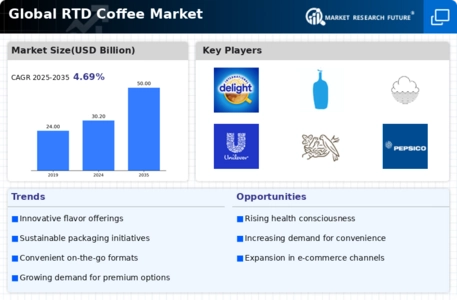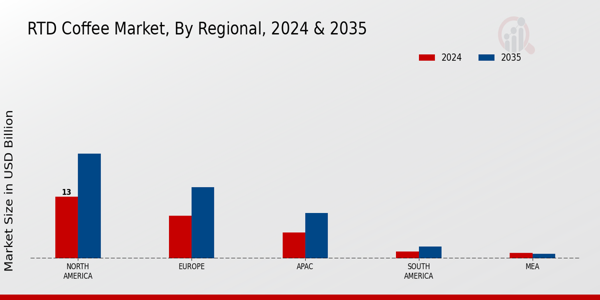Innovative Product Offerings
Innovation plays a crucial role in the evolution of The Global RTD Coffee Industry. Companies are continuously introducing new flavors, formulations, and functional ingredients to attract diverse consumer segments. For instance, the introduction of cold brew and nitro coffee options has expanded the traditional coffee experience, appealing to younger demographics seeking unique taste profiles. Additionally, the incorporation of health-oriented ingredients, such as protein and adaptogens, is becoming increasingly prevalent. Market data suggests that these innovative offerings are contributing to a notable increase in market share, with certain brands reporting growth rates exceeding 10% in specific segments. This trend indicates that consumers are not only looking for convenience but also for products that align with their lifestyle choices, further propelling the industry's expansion.
Growing Demand for Specialty Coffee
The rise of specialty coffee culture has significantly influenced The Global RTD Coffee Industry. Consumers are becoming more discerning about their coffee choices, seeking high-quality, artisanal products that offer unique flavor experiences. This shift is evident in the increasing popularity of premium RTD coffee brands that emphasize sourcing, roasting, and brewing techniques. Market data reveals that specialty coffee sales have outpaced traditional coffee sales, with a growth rate of around 8% annually. This trend is likely to continue as consumers prioritize quality over quantity, leading to a greater willingness to pay a premium for exceptional products. As a result, brands that focus on specialty offerings are well-positioned to capture a larger share of the market, appealing to a sophisticated consumer base.
Sustainability and Ethical Sourcing
Sustainability has emerged as a pivotal concern for consumers, influencing their purchasing decisions in The Global RTD Coffee Industry. There is a growing expectation for brands to adopt sustainable practices, including ethical sourcing of coffee beans and environmentally friendly packaging. Consumers are increasingly aware of the impact of their choices on the environment, leading to a demand for products that align with their values. Market data suggests that brands emphasizing sustainability are experiencing a competitive advantage, with sales growth in this segment outpacing traditional offerings. Companies that commit to transparent sourcing practices and eco-friendly initiatives are likely to resonate with a conscientious consumer base, thereby enhancing brand loyalty and market share. This trend indicates that sustainability will continue to be a driving force in shaping the future of the industry.
Convenience and On-the-Go Consumption
The increasing pace of modern life has led to a growing demand for convenience in food and beverage choices. The Global RTD Coffee Industry is experiencing a surge in products designed for on-the-go consumption, catering to busy professionals and students. This trend is reflected in the market data, which indicates that ready-to-drink coffee sales have seen a compound annual growth rate of approximately 7% over the past few years. Consumers are increasingly seeking quick and easy options that do not compromise on quality or taste. As a result, manufacturers are innovating with packaging solutions that enhance portability, such as resealable bottles and single-serve cans. This focus on convenience is likely to continue driving growth in the industry, as more consumers prioritize efficiency in their daily routines.
E-commerce and Digital Marketing Strategies
The rise of e-commerce has transformed the way consumers purchase beverages, including those in The Global RTD Coffee Industry. Online shopping platforms provide convenience and accessibility, allowing consumers to explore a wider range of products than what is available in physical stores. This shift has prompted brands to invest in digital marketing strategies to enhance their online presence and engage with consumers effectively. Data indicates that online sales of RTD coffee have increased significantly, with some brands reporting a growth of over 15% in e-commerce channels. This trend suggests that companies that leverage digital platforms and social media to connect with consumers are likely to thrive in the competitive landscape. As e-commerce continues to evolve, it may reshape consumer purchasing behaviors and preferences in the industry.
























Leave a Comment